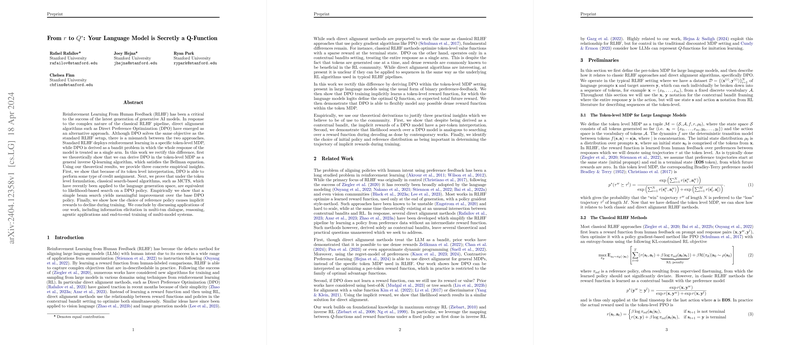Revisiting Token-Level Optimization in LLMs with Direct Preference Optimization
Introduction to DPO in Token-Level MDPs
Reinforcement Learning From Human Feedback (RLHF) remains a mainstay in aligning LLMs to human-defined objectives. Historically, these methods have relied heavily on Reward Models trained via human feedback, imposing considerable complexity. Direct Preference Optimization (DPO), a more recently formulated direct alignment method, simplifies the RLHF pipeline by bypassing the explicit reward model stage. Traditional approaches employ reinforcement learning to optimize token-level value functions derived from sparse reward signals collected upon completion of response generation. By contrast, DPO operates fundamentally at a single decision point perspective, akin to dealing with each complete response as an individual entity within a contextual bandits framework. This raises interesting theoretical challenges, particularly when translating DPO to function effectively at the token level.
DPO and Token-Level Derivations
A closer examination reveals that DPO can be theoretically integrated into the token-level Markov Decision Process (MDP) setting traditionally used for training LLMs. This transition involves interpreting DPO as a general inverse Q-learning algorithm, where the alignment between a model's responses and the desired reward signals manifested in human preferences can be realized across the sequential decision-making process of language generation.
Key Theoretical Insights
- Token-Level Interpretation: When re-formulated to accommodate the sequential token generation process, DPO demonstrates the ability to perform credit assignment at each token, attributing different weights to each decision point based on its contribution to the final outcome.
- Equivalence to Search-Based Methods: The foundational principles of DPO suggest that, under a token-level framework, it shares similarities with search-based algorithms such as Monte Carlo Tree Search (MCTS). Specifically, the theoretical re-interpretation posits that optimizing the DPO policy during the decoding phase is analogous to conducting a likelihood-based search across potential decision paths token by token.
- Role of Initial Policy Choices: The deployment of different reference policies during training influences the trajectory of implicit rewards. Understanding this relationship can guide more effective training regimens that retain or enhance the model's adherence to desired behavior patterns.
Empirical Findings and Practical Applications
By applying the theoretical insights to practical scenarios, the paper also confirms several key phenomena:
- Credit Assignment and Policy Improvement: Empirical results validate that DPO, when adapted to the token-level, can assign credit effectively and improve over the base policy using beam search strategies.
- Dynamic Behavior of Implicit Rewards: Observations indicate that the selection of initial policies significantly affects the evolution of implicit rewards during training, underscoring the delicate balance required in setting up initial conditions for DPO.
Future Directions and Speculations
This work invites further exploration into the granular controls and theoretical implications of direct preference optimization methods, considering their potential to streamline and potentially enhance the training of LLMs for complex, nuanced tasks. The adaptation of DPO into a token-level MDP framework not only bridges a critical gap in applying bandit-like strategies to more expansive sequential decision-making landscapes but also reinforces the model's ability to engage in nuanced, contextually driven language generation tasks.
Exploring the intersection of DPO with other RL techniques and extending these concepts to multimodal contexts or more complex interaction frameworks could further uncover latent potentialities in generative model training methodologies. The continuous evolution of LLMs and their training algorithms promises a fertile ground for advancing our understanding and capabilities in AI-driven natural language understanding and generation.
